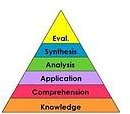A Look at Bloom's Taxonomy: How to Integrate Technology Integration Into the Curriculum
Bloom’s Taxonomy places thinking skills in a leveled hierarchy that can really help teachers to design objective-based lessons by helping
them understand what thinking skills students need to perform certain tasks. Integrating Bloom’s Taxonomy with technology into curriculum creates more ways to deliver information and creates engaging ways for students to interact with that information. Technology also offers students a variety of methods to prove that they have met specific learning objectives.
Delivering Instruction
After a teacher has determined what a learning objective is and how students will demonstrate that learning, the task of designing the actual lesson can start. Technology can help us to deliver instruction in a variety of ways. Teachers can integrate videos and other audio/visual presentations to present information when students need to demonstrate knowledge, or simple remembering. Deliver facts that the students will be expected to write, recite or display in some form from their memory.
A teacher may want to integrate more interactive instruction when the student objective is understanding. Students can demonstrate comprehension, or understanding through classifying concepts, comparing them and distinguishing them from others. Of course, there are a host of other verbs that fit into this level of Lower Order Thinking Skills (LOTS). A teacher can use technology to employ tools such as interactive Venn Diagrams for students to classify concepts. Depending on the particular concept being taught, students can organize text, images or even sounds in this manner. An inventive and technologically-literate teacher can develop a variety of other activities.
Application moves toward Higher Order Thinking Skills (HOTS). The sheer volume of factual information available on the Internet can aid a teacher in applying examples of application into his or her teaching. Application deals with putting information to use in real-world situations. Teachers can demonstrate this by explaining ideas and then relating them to actual scenarios (past or present). Teachers can find examples in the form of videos from around the world, actual photographs depicting applicable events and primary sources of documents pertaining to historical information.
Evidence of Learning
Teachers can sometimes fail to realize the true potential of integrating technology into curriculum by not considering it as a vehicle to demonstrate student learning. Teachers see success when students demonstrate they can do what they intend the students to do. Allowing students to use all the technological tools at their disposal in order to do this can accommodate their different learning styles, (<strong>Multiple Intelligences</strong>) and will allow them to work with the kinds of tools they probably use at home and will definitely have to master in the 21st century workplace.
In the past, demonstrating knowledge meant taking a paper and pencil test or writing a paper. Students may have also had the chance to give an oral presentation (usually by reading a paper they have written) or creating a bulletin board type of presentation. Today, students have so many more options to prove they have met the Higher Order Thinking Skill objectives of Analysis, Synthesis and Evaluation.
Don’t be afraid to let students create meaningful audio/visual presentations, videos or animations to deliver their analysis of information. These options can be more or less difficult depending on the technological ability and comfort level by teacher and students. It is important to allow students to operate within their means to show what they know.
Students definitely need to have more freedom to display that they can synthesize information. By Bloom’s definition, synthesis creates something new. Let students create according to their abilities and allow them to with the tools they are familiar with and which they are capable of using. Very little needs to be off limits. Students might create songs, record podcasts or even a website.
Evaluation
Evaluation may be at the very top of Bloom’s Taxonomy, but demonstrating it with technology may be a simpler task then demonstrating some of the Lower Order Thinking Skills. A group of students can collaborate to make an audio or video recording of a debate. A student might use a simple PowerPoint type presentation to show justification for her position or interpret findings or data. But again, these aren’t the limits to what a student can do. Students may think of options that you have not; they often do.
Assessment
When teachers incorporate Bloom’s taxonomy and technology integration into curriculum, they open up many ways that students candemonstrate that they have reached a set of predetermined learning objectives. It’s important to assess them in valid and fair ways. So I’m not suggesting telling students to “do whatever you want, as long as it proves that you have synthesized information.” Students need more direction in exactly what they are going to prove and how the teacher will evaluate their work. Flexible rubrics may be useful, but sometimes teachers may have to individualize the assessment criteria with (not for) each student. This can end up becoming quite a task for the teacher, so don’t bite off more than you can chew. Add technology components slowly, if need be, but don’t be afraid to use them.
References
Source: Author’s own experience
Churches, Andrew. “Bloom’s Taxonomy Blooms Digitally”
